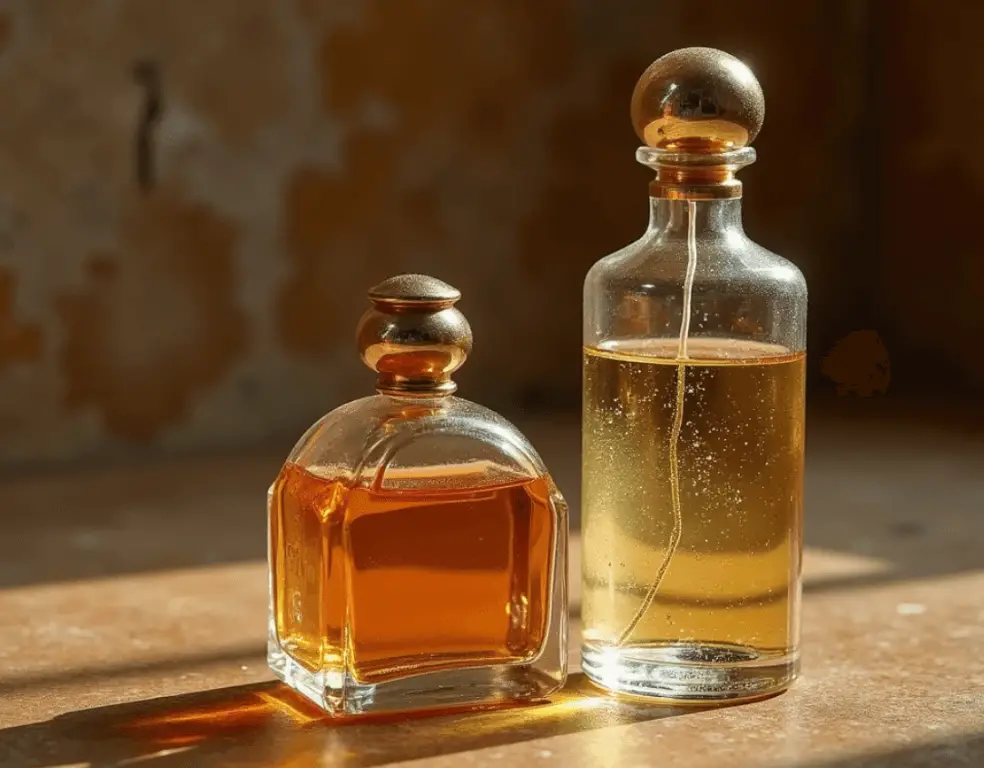Modern perfumery stands as a fascinating blend of art and science, where fragrant essential oils, aroma compounds, and solvents come together to create captivating scents.
The journey of perfume began in ancient civilizations like Mesopotamia, Egypt, and the Indus Valley, where the first recorded chemist, a woman named Tapputi, crafted early fragrances by distilling flowers and oils.
Today’s perfume industry has evolved dramatically since the late 19th century, when groundbreaking developments in synthetic aromatics like vanillin and coumarin opened new possibilities for scent creation.
In our contemporary world, perfumes are classified into distinct categories based on their concentration levels, ranging from the highly concentrated Parfum (15-40% aromatic compounds) to the lighter Eau Fraîche (3% or less).
The modern fragrance wheel, created by consultant Michael Edwards in 1983, organizes scents into five main families: Floral, Oriental, Woody, Aromatic Fougère, and Fresh.
This system has revolutionized how we understand and categorize perfumes, making it easier for both professionals and consumers to navigate the vast world of fragrances.
The perfume market continues to grow, with an impressive annual growth projection of 5% through 2027. Brands like Parfû exemplify the industry’s evolution, combining traditional craftsmanship with modern innovations such as sustainable practices and bespoke creations.
The contemporary relevance of perfumery extends beyond mere fragrance, as 70% of consumers now prioritize eco-conscious brands that emphasize ethical sourcing and environmental responsibility.
This shift reflects how modern perfumery has become not just about creating pleasant scents, but about embodying values that resonate with today’s conscious consumers.
The Evolution of Fragrance
The journey of fragrance began over 4,000 years ago in ancient Mesopotamia, where the world’s first recorded chemist, Tapputi, developed groundbreaking scent extraction techniques.
The Sumerians and Egyptians used natural ingredients like flowers, herbs, and resins for religious ceremonies and daily life, marking the dawn of perfumery.
During the Islamic Golden Age, significant advancements emerged when Ibn Sina (Avicenna) revolutionized perfumery by introducing the distillation process for extracting oils from flowers.
This innovation led to the creation of more delicate fragrances like rose water, which quickly gained popularity throughout the ancient world.
Modern perfumery took a dramatic turn in the late 19th century with the discovery of synthetic aromatics.
The development of compounds like vanillin and coumarin opened new possibilities for scent creation. Today’s fragrance industry, valued at $48 billion, combines traditional craftsmanship with cutting-edge technology.
Recent technological advancements have transformed perfume manufacturing through AI and biotechnology. Companies like Givaudan and Chanel now use artificial intelligence to analyze consumer preferences and create personalized scents.
Microbial-based approaches have emerged as sustainable alternatives for producing terpene derivatives, offering more practical and economical solutions than traditional methods.
The industry continues to evolve with innovations like smart perfume bottles and AI-powered fragrance creation. These technologies can dispense precise amounts of scent or even mix different fragrances based on personal preferences.
Environmental consciousness has also driven the development of eco-friendly packaging and sustainable production methods, with many brands now focusing on biodegradable materials and refillable bottles.
Composition Structure
Concentration Levels
The strength of a fragrance is determined by its concentration of aromatic compounds. Parfum, the most concentrated form, contains 20-40% aromatic compounds and can last up to 8 hours on the skin. Eau de Parfum follows with 15-20% concentration, providing 4-8 hours of scent presence.
Eau de Toilette contains 5-15% aromatic compounds and typically lasts 3-4 hours, making it perfect for daytime wear. The lightest concentration, Eau de Cologne, contains 2-5% aromatic compounds and provides about 2 hours of fragrance.
The Note Pyramid
The olfactory pyramid represents how fragrances evolve over time through three distinct phases:
Top Notes
These are the first scents detected immediately after application. Typically featuring light, fresh ingredients like:
- Citrus (bergamot, lemon)
- Herbal (mint, lavender)
- Green notes
These volatile compounds evaporate within 5-30 minutes.
Middle Notes
Also called heart notes, these emerge as top notes fade and form the fragrance’s core character. Common middle notes include:
- Floral essences (rose, jasmine)
- Spicy elements
- Fruity compounds
These notes become apparent after 15 minutes and can last several hours.
Base Notes
The foundation of the fragrance provides depth and longevity. These heavy molecules include:
- Woody elements (sandalwood, cedar)
- Musk
- Vanilla
- Amber
Base notes develop after 30 minutes and can last 24+ hours on the skin.
Contemporary perfumes typically contain 150-250 individual components working together across these three levels. The sophisticated interplay between calming, stimulating, and attractive notes determines a perfume’s overall character.
Research shows that base notes also interact with skin chemistry, explaining why the same perfume can smell different on different people.
A study published in the European PMC reveals that modern perfumes combine essential oils from natural extracts with synthetic aromatics, classified by structural groups like alcohols, esters, aldehydes, and terpenes.
These components are carefully balanced with fixatives to reduce evaporation and improve stability, typically in a solution of 98% ethanol and 2% water.
Fragrance Families
Traditional Fragrance Categories
Citrus Fragrances offer bright, energizing scents featuring notes of bergamot, lemon, lime, and grapefruit. These perfumes typically last 2-3 hours and create an uplifting, fresh atmosphere perfect for daytime wear. Popular examples include 4711 Original and Dior Homme Cologne.
Floral Fragrances represent the most widely used family in perfumery, featuring either single flower notes (soliflores) or complex bouquets. These scents can include rose, jasmine, lily, and violet, creating elegant and sophisticated compositions. They often form the heart of many modern perfumes.
The Oriental Family (now often called Amber) combines warm, spicy notes with sweet undertones. Key ingredients include vanilla, amber, cinnamon, and cardamom, creating rich and sensual fragrances that last 6-8 hours. These perfumes work especially well for evening wear and special occasions.
Woody Fragrances feature warm, earthy notes derived from materials like sandalwood, cedarwood, patchouli, and vetiver. These scents are often unisex and provide excellent longevity, making them suitable for both day and evening wear.
Modern Interpretations
Fusion Scents have revolutionized traditional categories by creating innovative combinations:
- Citrus-Woody: Combines fresh citrus with grounding wood notes
- Floral-Oriental: Merges floral elements with spicy warmth
- Woody-Aquatic: Blends woody bases with fresh marine notes
Niche Categories have emerged as a distinct market segment, offering unique and sophisticated compositions. These fragrances typically:
- Use higher quality ingredients
- Feature more complex compositions
- Offer longer lasting scents
- Focus on artistic expression rather than mass appeal
Modern perfumery has also introduced new subcategories like Gourmand (featuring food-like scents) and Green (emphasizing natural, herbal notes). The industry continues to evolve with sustainable practices and innovative ingredient combinations, creating increasingly sophisticated and personalized fragrance experiences.
Application Techniques
Strategic Pulse Points
The key to effective fragrance application lies in targeting pulse points – areas where blood vessels run close to the skin’s surface.
The most effective spots include the wrists, neck, behind the ears, and the inner elbows. Hold the perfume bottle 6-8 inches away from your skin and spray lightly without rubbing, as this can break down the fragrance molecules.
Read More: Carlos Scola Pliego: The Enigmatic Filmmaker Behind the Lens
Layering for Longevity
Fragrance layering creates a more complex and lasting scent profile. Start with a scented body wash, follow with a matching body lotion, and finish with your perfume. This technique helps lock in the fragrance and can extend its wear time by up to 3-4 hours.
Seasonal Application Strategies
Adapt your application technique based on the season:
Warm Weather
- Use lighter applications on pulse points
- Focus on areas with good air circulation
- Apply to lower body points for a subtle rising effect
Cold Weather
- Apply to well-moisturized skin
- Focus on warm areas like the neck and chest
- Consider additional application points for stronger projection
For optimal results, apply fragrance right after showering when pores are open, and skin is slightly damp. Remember that heat and humidity affect fragrance projection, so adjust the number of sprays accordingly – typically 2-4 sprays are sufficient for most occasions.
Innovation in Modern Perfumery
Sustainable Innovation
The perfume industry is embracing eco-friendly practices through initiatives like the Sustainable Scents program. Companies now prioritize water conservation, waste reduction, and renewable energy in their manufacturing processes.
Natural extraction techniques and biodegradable packaging have become industry standards, reducing environmental impact while maintaining luxury appeal.
Personalization Revolution
AI-driven perfumery is transforming how fragrances are created and experienced. Systems like Philyra, developed by IBM Research and Symrise, analyze vast databases of 1.7 million formulas to create personalized scents.
Modern perfume brands offer customization workshops where customers can create their own signature fragrances, with some companies using AI algorithms to match preferences with specific scent profiles.
Digital Integration
The emergence of digital perfume technology is revolutionizing fragrance experiences. New innovations include scent speakers like Cyrano that emit programmed “playlists” of smells, and AI-powered diffusers that sync with users’ calendars.
Microencapsulation technology enables fragrances to release gradually throughout the day, responding to factors like body heat and environmental conditions.
The industry has also embraced biotechnology for sustainable ingredient sourcing and machine learning for formula development. Companies like Scentee Machina are integrating smart technology with traditional perfumery, allowing users to control fragrances through smartphone apps.
This digital transformation has led to more efficient production methods and enhanced customer experiences, with the digital perfume market showing significant growth potential through 2027.
Performance Factors
Environmental Impact
Temperature and humidity significantly affect fragrance performance. In hot weather, perfumes evaporate faster, making top notes more prominent and increasing projection. High humidity enhances longevity by keeping skin moist and slowing evaporation rates, while dry conditions cause fragrances to fade more quickly.
Personal Chemistry Factors
Your unique body chemistry determines how a perfume develops on your skin. Pheromones, natural oils, and sweat interact with fragrance molecules to create individual scent profiles.
Diet and lifestyle also influence perfume performance – certain foods like garlic or spicy meals can temporarily alter how fragrances interact with your skin.
Storage Solutions
To maintain fragrance integrity, store perfumes in cool, dark places away from direct sunlight and heat sources. The ideal storage temperature should remain consistent, as fluctuations can degrade the fragrance compounds. Proper sealing is crucial – always ensure bottles are tightly closed to prevent oxidation.
Key Storage Tips:
- Keep perfumes in original packaging
- Avoid bathroom storage due to humidity
- Store at room temperature
- Minimize exposure to air and light
Studies show that fragrance ingredients have varying environmental impacts depending on their production process and raw materials used. Proper storage and understanding of personal chemistry factors can help maximize perfume performance and longevity while minimizing environmental impact.
Conclusion
The fragrance industry is poised for remarkable growth, projected to reach $49.05 billion by 2030, with a steady CAGR of 7.6%. This expansion is driven by evolving consumer preferences and technological innovations.
Consumer behavior is shifting dramatically toward personalized experiences and sustainable products. AI-driven perfumery and digital technology are transforming how fragrances are created and experienced, with systems like Philyra analyzing millions of formulas to create custom scents.
The market is seeing a surge in demand for premium and niche fragrances, particularly in emerging markets across Asia Pacific and the Middle East.
Environmental consciousness is reshaping industry practices. Companies are embracing regenerative agriculture for ingredient sourcing and developing zero-waste packaging solutions.
The rise of organic perfumes and vegan fragrances reflects a broader commitment to sustainability, with brands focusing on biodegradable materials and refillable bottles.
This transformation extends beyond product development to include sustainable supply chains and reduced carbon footprints, ensuring the industry’s long-term viability while meeting consumer demands for eco-friendly options.


